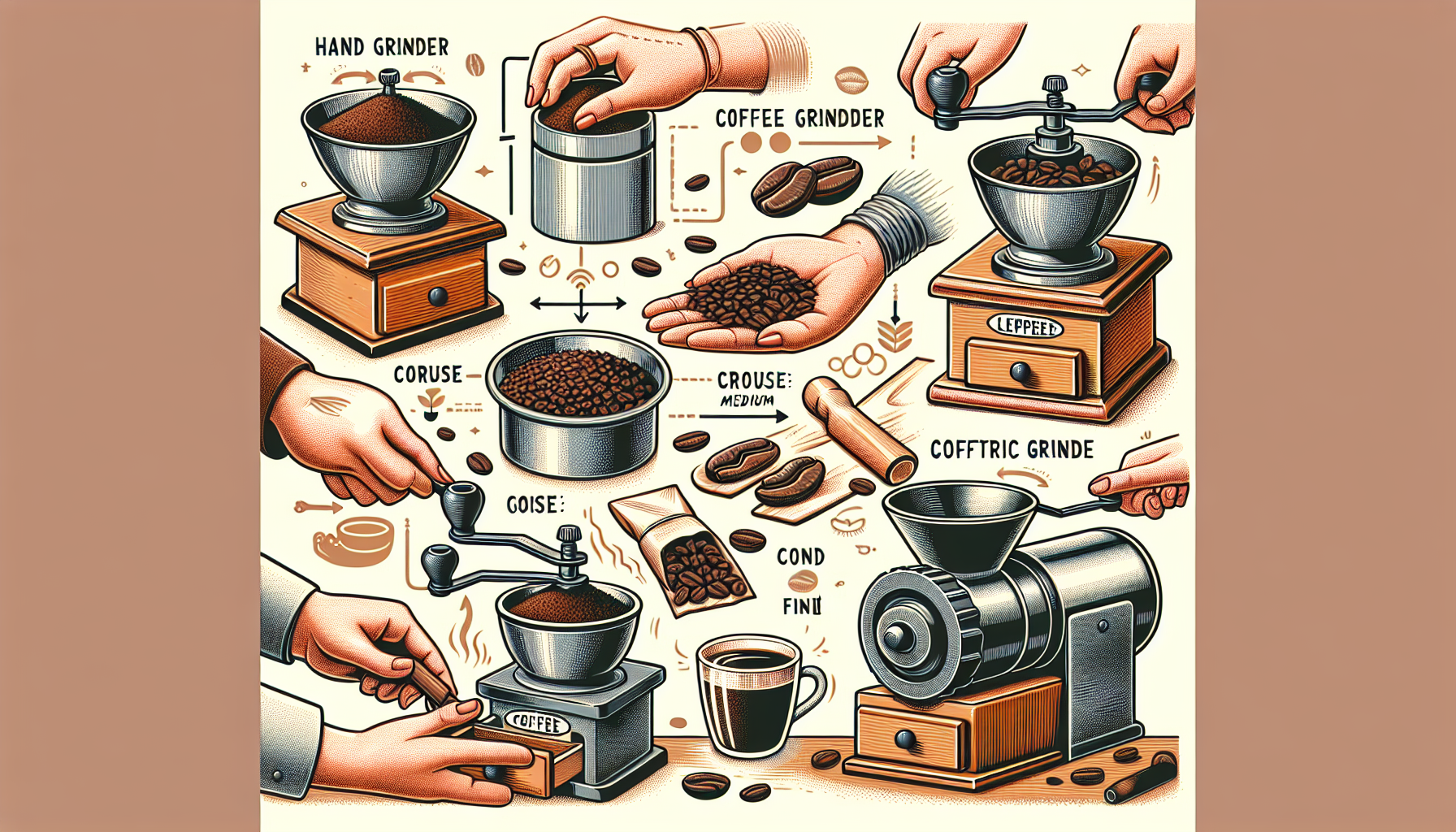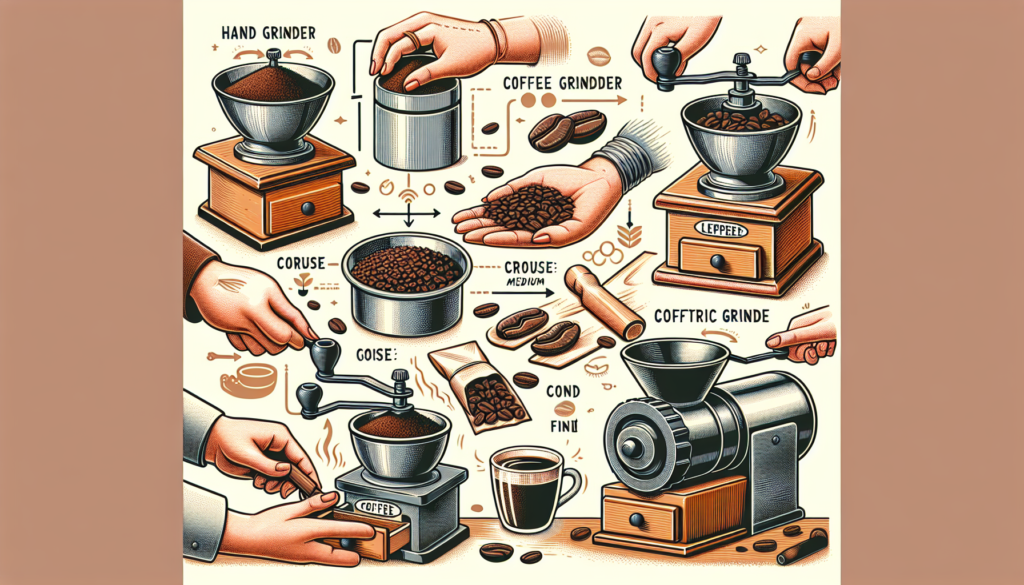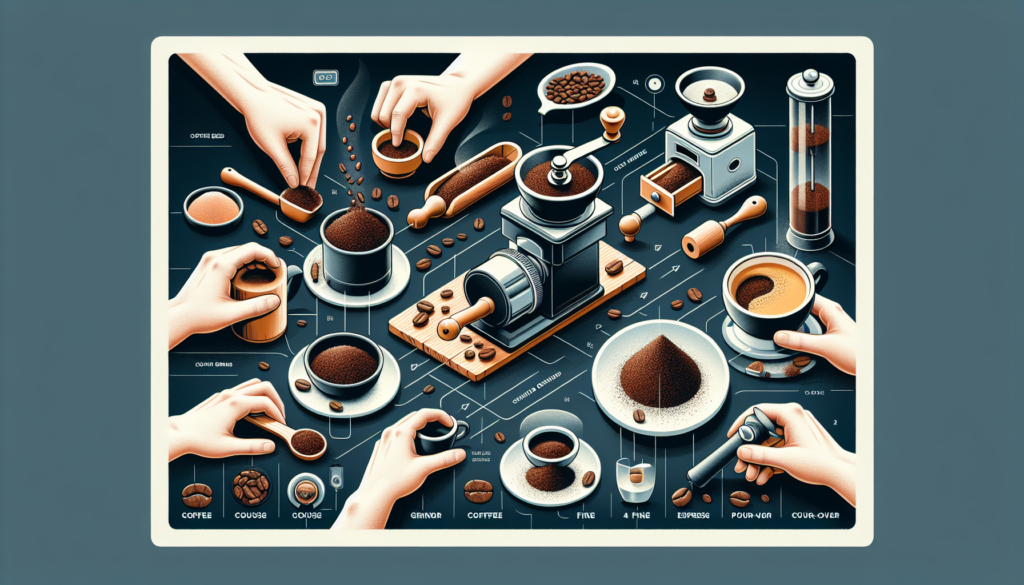
Are you a coffee enthusiast looking to perfect your brew? Look no further! Our article, “Coffee Grinding Techniques: Tips For Beginners To Experts,” provides valuable advice on achieving the perfect grind for every coffee preference. Whether you’re just starting out or consider yourself an experienced barista, this article offers tips and tricks to help you elevate your coffee brewing skills. From understanding grind sizes to exploring different grinding methods, we have you covered. Get ready to unlock the secrets to a flavorful and aromatic cup of coffee with our comprehensive guide.

Choosing the Right Coffee Grinder
Before diving into the world of coffee grinding, it is crucial to choose the right coffee grinder that suits your needs. The two main types of grinders available are manual and electric grinders. Manual grinders are perfect for those who appreciate the hands-on approach and enjoy the process of grinding their coffee beans. On the other hand, electric grinders provide convenience and speed, allowing you to effortlessly grind your beans with just the touch of a button. Consider your preferences, lifestyle, and coffee brewing routine when deciding between manual and electric grinders.
Another aspect to consider is whether to opt for a burr grinder or a blade grinder. Burr grinders are known for their consistent grind size and are highly recommended for achieving the best flavor profiles. They crush coffee beans between two revolving abrasive surfaces, resulting in a uniform grind size. In contrast, blade grinders use metal blades to chop the coffee beans, often leading to an inconsistent grind. Although blade grinders are generally more affordable, the lack of grind consistency can affect the overall quality of your brewed coffee. Ultimately, the choice between burr and blade grinders depends on your priority for consistent grind size and extraction.
Grind Size and Coffee Extraction
Understanding the concept of grind size is essential for achieving the perfect cup of coffee. Grind size refers to the coarseness or fineness of the coffee particles after grinding. Different brew methods require specific grind sizes to ensure optimal extraction and flavor.
The grind size has a significant impact on coffee extraction. For example, a finer grind size increases the surface area of the coffee particles, leading to faster extraction. This results in a stronger and often more bitter flavor. On the other hand, a coarser grind slows down extraction, yielding a milder taste. It is crucial to match the grind size to your desired brewing method to achieve the optimal balance of flavors.
Various brewing methods call for different grind sizes. For espresso, a fine and consistent grind is necessary to ensure proper extraction within a short brewing time. Pour over methods, such as V60 or Chemex, require a medium to fine grind size to achieve a balanced extraction. French press brewing, on the other hand, requires a coarse grind to prevent over-extraction and bitterness. Lastly, AeroPress brewing calls for a medium grind, striking a balance between extraction time and flavor.
The Importance of Consistency
Consistency in grind size is vital for brewing consistent and flavorful coffee. A uniform grind ensures an even extraction, allowing you to achieve the desired balance of flavors with every cup. Inconsistencies in grind size can result in under-extraction or over-extraction, leading to uneven flavor profiles.
Several factors can affect the consistency of grind size. Firstly, the quality of the grinder plays a significant role. Higher-quality grinders, especially burr grinders, tend to produce more consistent grind sizes compared to cheaper blade grinders. Additionally, the type of beans used and their moisture content can impact the consistency. Beans that are too oily or too dry can result in uneven grinding.
To achieve consistency in grind size, it is crucial to invest in a high-quality grinder and ensure proper maintenance. Regularly cleaning your grinder and checking for any misalignment can help maintain a consistent grind. Also, ensuring that your grinder is properly calibrated and adjusted can have a significant impact on the consistency of your grind size.

Understanding the Brewer’s Relationship with Grind Size
The grind size has a direct impact on brewing parameters, such as brewing time, water temperature, and extraction rate. As a brewer, it is crucial to understand how these parameters are influenced by the grind size to achieve optimal results.
When selecting the grind size, it is essential to match it to the brewing method you intend to use. Different brewing methods require specific grind sizes to optimize flavors. For instance, when brewing with a French press, a coarse grind is recommended to allow for a longer extraction time. In contrast, for espresso, a fine grind is necessary to ensure a short extraction time.
To adjust the grind size for extraction and flavor, it is crucial to experiment and make small adjustments until you achieve the desired taste. Finer grind sizes generally result in a more intense and bitter flavor, while coarser grind sizes lead to a milder and less intense flavor. By fine-tuning the grind size based on your preference and the characteristics of your coffee beans, you can create a customized brewing experience.
Grinding Techniques for Different Brewing Methods
Grinding techniques vary depending on the brewing method you prefer. Understanding the specific requirements for each method will help you achieve the best possible flavor and extraction.
For espresso brewing, a fine and consistent grind size is crucial. It is recommended to adjust the grind size so that the extraction time falls within the optimal range of 25 to 30 seconds. This ensures the extraction of the rich flavors and aromas that characterize a great espresso shot.
If you prefer pour-over brewing methods like V60 or Chemex, a medium to fine grind size is ideal. The specific extraction time and flavor profile can be adjusted by fine-tuning the grind size within this range. It is important to pour the water evenly and in a controlled manner over the coffee bed to ensure an even extraction.
When brewing with a French press, a coarse grind size is necessary to prevent over-extraction and bitterness. The coarser grind allows the coffee grounds to be fully saturated while still providing a clean and balanced flavor.
For AeroPress brewing, a medium grind size is recommended. This balanced grind size allows for a relatively short extraction time while still extracting the desired flavors from the coffee grounds.
Tips for Achieving the Best Flavor
To achieve the best flavor from your coffee, there are a few helpful tips to keep in mind. First and foremost, it is important to experiment with different grind sizes to find the one that best suits your taste preferences. Small adjustments can make a significant difference in the overall flavor profile.
Controlling the grind time is another crucial aspect to consider. Grinding for too long can result in heat build-up, which can potentially negatively affect the flavor. It is recommended to pulse or grind in short bursts to prevent excessive heat generation.
Storing coffee beans properly is also essential for maintaining the freshness and flavor of your coffee. It is recommended to store beans in an airtight container away from direct sunlight and excessive heat. This helps to preserve the flavors and aromas until you are ready to grind and brew your coffee.
Troubleshooting Common Grinding Issues
Grinding issues can occasionally arise, affecting the flavor and quality of your coffee. Understanding common issues and how to troubleshoot them can help you overcome these obstacles.
Over-extraction and bitterness can occur when using too fine of a grind size or when the brewing time is too long. To rectify this issue, it is recommended to adjust the grind size to be coarser or reduce the brewing time.
Under-extraction, resulting in a weak taste, can be caused by using too coarse of a grind size or not allowing sufficient brewing time. Adjusting the grind size to be finer or extending the brewing time can help mitigate this issue.
Uneven extraction can occur when the grind size is inconsistent or when the brewing method is not properly executed. To address this, focus on achieving a consistent grind size and ensure proper brewing techniques are followed.
Cleaning and maintenance are crucial for keeping your grinder in optimal condition. Regularly cleaning your grinder, especially the burrs or blades, helps prevent residue build-up and potential flavor contamination. Additionally, maintaining proper alignment and calibration can ensure a more consistent grind size.
Exploring Alternative Grinding Methods
While electric grinders are the most common choice for coffee enthusiasts, there are alternative grinding methods that can be explored. Hand grinding techniques, using a manual grinder or a hand grinder attachment for a hand blender, provide a different level of control and an opportunity to connect with the coffee-making process on a deeper level.
Grinding coffee with a mortar and pestle is another alternative that can be explored. This traditional method allows for a hands-on and intimate grinding experience, perfect for those seeking a unique and engaging approach to coffee preparation.
Grinding for Specialty Coffee
When it comes to specialty coffee, grind size plays a crucial role in the overall coffee experience. Single-origin coffees, which are sourced from a specific region and often have unique flavor profiles, often require specific grind sizes to bring out their best characteristics.
When preparing cold brew coffee, a coarse grind size is recommended. This allows for a longer steeping time and extraction, resulting in a smooth and flavorful cold brew.
Grind size also has a significant impact on cupping. Cupping is a professional coffee-tasting technique used to evaluate different coffees. The grind size used for cupping is typically coarse to allow for proper extraction and evaluation of each coffee’s distinct flavors.
The Art of Dialing-In
Dialing-in refers to the process of fine-tuning the variables involved in coffee brewing to achieve the desired flavor. This includes adjusting the grind size, brewing time, water temperature, and coffee-to-water ratio.
Understanding dialing-in allows coffee enthusiasts to create a personalized and customized brewing experience. By fine-tuning each parameter to their preferences, they can discover the perfect balance of flavors that suits their taste.
A step-by-step guide to dialing-in begins with choosing a starting point for grind size based on the preferred brewing method. From there, adjustments can be made by gradually increasing or decreasing the grind size until the desired flavor is achieved. This process may require some experimentation and patience, but the results can be highly rewarding.
Fine-tuning for personal preference is the final step in the dialing-in process. Once the initial parameters have been established, further adjustments can be made based on personal taste preferences. Whether it’s tweaking the grind size, brewing time, or water temperature, the goal is to create a brewing method that consistently produces the desired flavor profile.
In conclusion, choosing the right coffee grinder and understanding the impact of grind size on coffee extraction are essential steps in the journey towards brewing the perfect cup of coffee. Consistency in grind size, the relationship between the grind size and the brewing parameters, and the proper grinding techniques for different brewing methods further enhance the quality of your brew. Tips for achieving the best flavor, troubleshooting common grinding issues, and exploring alternative grinding methods provide valuable insights for coffee enthusiasts of all levels. With the art of dialing-in, you can refine your brewing process to meet your unique taste requirements and enjoy the wonderful world of coffee.